3.1 Leaves
Learning objectives
By the end of this lesson you will be able to:
- Identify the parts of the angiosperm leaf.
- Describe some of the ways in which leaf parts differ from plant to plant.
- Recognize the basic patterns of leaf shape and orientation of the veins in the leaves.
Leaves
Leaves are shoot structures that attach to stems and branches at nodes. Leaves are made up of cells that usually contain a high concentration of chloroplasts (cell organelles unique to plants) and are specialized sites for photosynthesis. We will explore photosynthesis in greater detail later; for now, remember that photosynthesis is the process of capturing light energy and converting it into chemical energy that can be stored in plants (like starch and sugar). In some plants, leaves may be modified for nutrient storage (as with onions, where the bulb is made up of fleshy leaves), or for support (as with peas, where some leaves are modified into tendrils that wrap around a trellis).
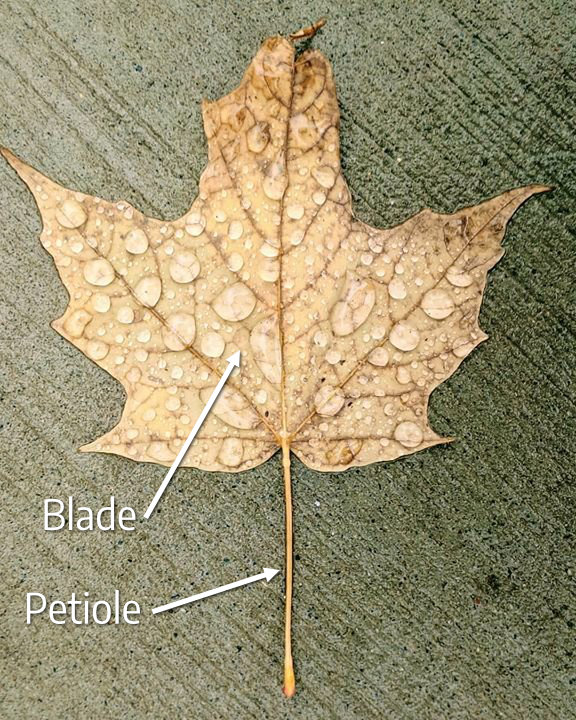
Leaves are also the surface where water that has moved from the soil into the roots and up through the plant finally evaporates back into the atmosphere in a process called transpiration.
Angiosperms, which are flowering plants whose seeds develop inside an ovary, tend to have flattened leaves. Many perennial angiosperms (flowering plants that can grow for many years) have leaves that senesce, or die, at the end of each growing season and are replaced at the beginning of the next growing season. Gymnosperms, plants whose seeds are produced without the protection of an ovary, tend to have needle-like leaves. Perennial gymnosperms tend to hang on to their leaves for a number of years. This saves energy, since the plant doesn’t need to grow a whole set of new leaves every year. The needle-like form helps retain moisture in harsh, dry climates, including those that are very cold and dry.
Leaf parts and venation
Angiosperm leaves typically have a blade or lamina, a flattened part with high chloroplast concentration. They may also have a petiole, the stalk that attaches the blade to the stem at a node. Stipules, small leaf-like bracts at the point of attachment of the petiole to the stem, may also be present. Some leaves have no petiole at all, and are termed sessile.
In contrast to the blade-petiole structure, grasses have a sheath-type structure in which the blade attaches to an envelope of leaf tissue that wraps around the shoot of the plant and then attaches to a lower node on the stem.
Leaf blades also have characteristic patterns of venation. In grasses, the veins lie parallel to each other and to the long edges of the leaf. We call this parallel venation, and it is typical of monocots. Most other angiosperms have a strong major midrib with veins branching from the midrib, smaller veins branching from those, and so on to form a netted venation throughout the leaf. This type of venation is typical of dicots.
Leaves may also have a palmate venation where several veins radiate from the point where the petiole attaches to the blade. Ginkgo tree leaves have palmate venation. The veins fork, then travel a bit, then fork again, travel, fork, and so on until the veins reach the margin (edge) of the leaf. Sugar maple leaves have a classic palmate venation with five lobes.
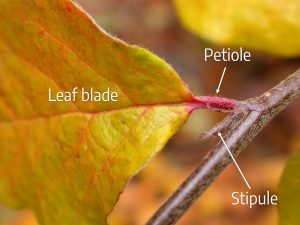
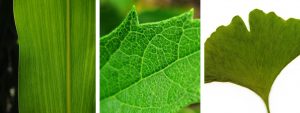
Watch this video on leaf veins:
Leaf segmentation
Simple leaves
Simple leaves have uninterrupted leaf margins. The leaf may have lobes like the oak leaf, but the blade has one continuous margin. The venation differs in the two examples below. The oak leaf is pinnate, with a major vein heading down the midrib of the leaf. The maple leaf is palmate, with major veins that radiate from the point of attachment to the petiole.
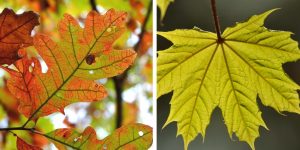
Compound leaves
The sumac leaf is a good example of how a compound leaf has a blade that is completely interrupted and segmented into separate leaflets. What you see in the picture — the entire thing — is one leaf. The leaf is divided or segmented into leaflets.
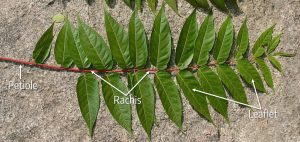
The petiole extends from the point of attachment at the node to the first leaflet. The central axis from that point on — from the first leaflet to the tip of the leaf — is called the rachis.
Virginia creeper is an example of a palmately compound leaf. The stalk that connects the leaflet to the top of the petiole is called the petiolule. In this case there is no rachis; all leaflets are attached directly to the top of the petiole.

Below is a compound leaf with three leaflets, called a trifoliate leaf. Soybean, clover, and dry bean all have trifoliate leaves. In contrast to the palmately compound leaf above, there is a rachis to which the central leaflet is attached.
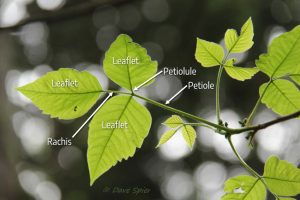
To tell whether a leaf is simple or compound, ook for attachment to a node. If the point of attachment doesn’t appear to be a node, it is likely a leaflet attached to the rachis of a compound leaf.
Watch this video on compound leaves:
Additional optional reading
For more information about leaves, explore this Wikipedia page, starting about halfway down at the heading “Morphology (large-scale features)” and continuing through “Veins.”
Review questions
- What advantage do angiosperm leaves have because they are flattened?
- What advantage do gymnosperm leaves have because they are needle-like?
- What is the difference between a simple leaf and a compound leaf?
- Is a petiolule found in a compound or simple leaf? To what structure does it attach?
- What is the difference between a leaf with palmate venation and a palmately compound leaf?
- Draw and label a picture of a leaf with these parts: rachis, petiole, petiolule, and leaflet.
A usually green, flattened, lateral structure attached to a stem and functioning as a principal organ of photosynthesis and transpiration in most plants.
Made up of a central axis (stem) with a repeating pattern of nodes and internodes.
Supporting and conducting organ usually developed initially from the epicotyl and growing upward and consists of nodes and internodes.
Vegetative growth coming from a node on the main stem.
Stem region of a plant where one or more leaves attach and is the location of lateral buds.
Organ that anchors the plant into the soil, takes up water and nutrients, and stores food.
Broad portion of a leaf and does not include the petiole.
Another name for a leaf blade.
Stalk by which most leaves are attached to a stem; it is part of the leaf structure, not the stem.
Usually a pair of appendages located at the base of a leaf but may be fused into a ring around the stem; variable in size, shape, and texture; serves for protection or to attract pollinators.
A modified leaf or scale, usually small, with a flower or flower cluster in its axil.
When a leaf lacks a petiole; called a sessile leaf.
Pattern of veins on a leaf.
Distribution or arrangement of a system of veins in a leaf blade in a non-intersecting network. The veins are parallel to each other and the long edge of the leaf.
Seed plant that produces an embryo with a single cotyledon and parallel-veined leaves; includes grasses, lilies, palms, and orchids.
Main vein, generally in the center of the leaf from which secondary veins emerge.
Seed plant that produces an embryo with paired cotyledons, floral organs arranged in cycles of four or five, and leaves with net-like veins.
Where several veins radiate from the point where the petiole attaches to the blade. The veins fork, then travel a bit, then fork again, travel, fork and so on until the veins reach the margin of the leaf.
Leaf with an uninterrupted blade margin.
Edge of the leaf blade.
Leaf with a blade margin that is completely interrupted and segmented into separate leaflets.
Small leaf-like structure that is found on compound leaves. Multiple leaflets make-up a single compound leaf.
Compound leaf where the petiolules of the leaflets connect directly to the petiole (no rachis).
Stalk that connects the leaflet to the top of the petiole.
Stalk of a flower that is situated between the peduncle and the pedicel.

